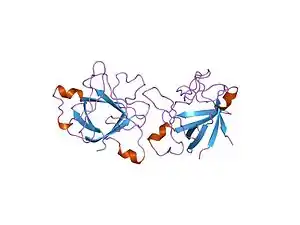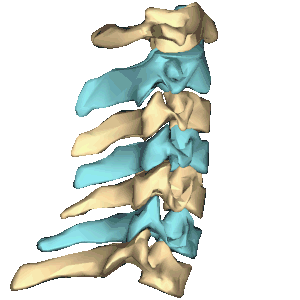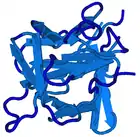Deficiency of the interleukin-1–receptor antagonist
Deficiency of the interleukin-1–receptor antagonist (DIRA) is an autosomal recessive, genetic autoinflammatory syndrome resulting from mutations in IL1RN, the gene encoding the interleukin 1 receptor antagonist.[6][7][2] The mutations result in an abnormal protein that is not secreted, exposing the cells to unopposed interleukin 1 activity. This results in sterile multifocal osteomyelitis, periostitis (inflammation of the membrane surrounding the bones), and pustulosis due to skin inflammation from birth.
| Deficiency of the interleukin-1–receptor antagonist | |
|---|---|
| Other names | Interleukin 1 receptor antagonist deficiency |
 | |
| Interleukin-1–receptor antagonist | |
| Specialty | Immunology |
| Symptoms | Joint pain[1] |
| Causes | Mutations in IL1RN gene[2][3] |
| Diagnostic method | Genetic test, Radiological findings[4][3] |
| Treatment | Colchicine [5] |
Symptoms and signs

DIRA displays a constellation of serious symptoms which include respiratory distress, as well as the following:[1][7]
- Joint swelling
- Hepatomegaly
- Osteomyelitis
- Fused cervical vertebrae
- Interstitial pulmonary abnormality
- Stomatitis
- Mouth ulcers
- Pustulosis or pustular psoriasis
- Cerebral vasculitis
Cause
Those affected with DIRA have inherited (via autosomal recessive manner) mutations in IL1RN,[2][3] a gene that encodes a protein known as interleukin 1 receptor antagonist,[8][2] The cytogenetic location of IL1RN is 2q14.1, while its 2:113,099,364-113,134,015 are the genomic coordinates[3]
Mechanism

The mechanism of deficiency of the interleukin-1–receptor antagonist affects the normal function of IL1RN gene. The protein produced by IL1RN gene prevents the normal activities of interleukin 1(alpha) and interleukin 1(beta). Therefore, the pathophysiologic immune and inflammatory responses are nullified.[3][8] Interleukin 1 receptor antagonist (IL1RN) has a total of five alleles, of those the (IL1RN*1) and (IL1RN*2) are the most common as the other alleles are seen less than 5 percent.[3]
IL-1RN binds to the same cell receptors as the inflammatory protein IL-1, and blocks its inflammatory actions. Without IL-1Ra, the body cannot control systemic inflammation that can be caused by IL-1.[9]
Diagnosis
Those affected with deficiency of the interleukin-1–receptor antagonist can have diagnosis achieved via noting an increase of erythrocyte sedimentation rate, as well as the following:[4][3]
- Genetic test
- Radiological findings
- Clinical findings
Treatment
In terms of treatment a 2013 review indicates that colchicine can be used for DIRA.[5] Additionally there are several other management options such as anakinra, which blocks naturally occurring IL-1, this according to a 2016 pediatric textbook.[10][11]
See also
References
- "Deficiency of interleukin-1 receptor antagonist| Genetic and Rare Diseases Information Center (GARD) – an NCATS Program". rarediseases.info.nih.gov. Retrieved 2017-06-11.
- "Osteomyelitis, sterile multifocal, with periostitis and pustulosis - Conditions - GTR - NCBI". www.ncbi.nlm.nih.gov. Retrieved 2017-06-11.
- "OMIM Entry - * 147679 - INTERLEUKIN 1 RECEPTOR ANTAGONIST; IL1RN". omim.org. Retrieved 2017-06-21.
- Griffiths, Christopher; Barker, Jonathan; Bleiker, Tanya; Chalmers, Robert; Creamer, Daniel (2016-02-29). Rook's Textbook of Dermatology. John Wiley & Sons. pp. 45–7. ISBN 9781118441176.
- Ter Haar, Nienke; Lachmann, Helen; Özen, Seza; Woo, Pat; Uziel, Yosef; Modesto, Consuelo; Koné-Paut, Isabelle; Cantarini, Luca; Insalaco, Antonella (May 2013). "Treatment of autoinflammatory diseases: results from the Eurofever Registry and a literature review" (PDF). Annals of the Rheumatic Diseases. 72 (5): 678–685. doi:10.1136/annrheumdis-2011-201268. hdl:2318/120618. ISSN 1468-2060. PMID 22753383. S2CID 9558024.
- Liaison, Janet Austin, Office of Communications and Public (2017-04-21). "Autoinflammatory Diseases". www.niams.nih.gov. Retrieved 2017-06-11.
- "OMIM Entry - # 612852 - OSTEOMYELITIS, STERILE MULTIFOCAL, WITH PERIOSTITIS AND PUSTULOSIS; OMPP". omim.org. Retrieved 2017-06-11.
- Reference, Genetics Home. "IL1RN gene". Genetics Home Reference. Retrieved 2017-06-12.
- Rezaei, Nima; Aghamohammadi, Asghar; Notarangelo, Luigi D. (2016-11-30). Primary Immunodeficiency Diseases: Definition, Diagnosis, and Management. Springer. p. 410. ISBN 9783662529096.
- Nelson Textbook of Pediatrics: The field of pediatrics. Elsevier Health Sciences. 2016. p. 1203. ISBN 9781455775668. Retrieved 22 June 2017.
- Pazyar, N; Feily, A; Yaghoobi, R (November 2012). "An overview of interleukin-1 receptor antagonist, anakinra, in the treatment of cutaneous diseases". Current Clinical Pharmacology. 7 (4): 271–5. doi:10.2174/157488412803305821. ISSN 2212-3938. PMID 22794157.subscription required
Further reading
- Schachner, Lawrence A.; Hansen, Ronald C. (2011). Pediatric Dermatology E-Book (Fourth ed.). Elsevier Health Sciences. ISBN 978-0723436652. Retrieved 11 June 2017.